#monster biology post
Explore tagged Tumblr posts
Text
nonhuman species martial arts
-werewolves who focus on agility, weaving around everything then finishing with a single hard bite to their opponent
-nagas who use their tails for extensive grappling moves, twisting someone all over the place and restraining them entirely
-multi-armed species with complicated patterns of arm blocking interspersed with frenzied sets of hits
-slimes making themselves utterly impossible to grab and shrugging off any punches they take
-lizardfolk and dragons that use their tails to hold additional weapons
anyway. gym where you can spar all kinds of creatures and martial art styles. and then the winner gets to fuck the loser. cmon you know what blog this is
451 notes
·
View notes
Photo
thick hair with chromatophores that gets used to communicate through color changes

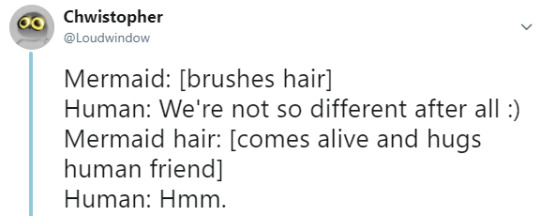
257K notes
·
View notes
Text

Aggression/ Danger to humans: Low – Low
Element/ Ailment: None
The Moss Crab or Josljësj Rhäm (Yoslyoesh Rawm), meaning “water-spider of moss” in Dhënuvgöm, is a species of Anthropod (Arthropods that have evolved internal skeletons closed, a circular system¸ andare Mesotherms). Moss Crabs are native to the first layer of the Hollows (also known as the First Hell) of the eastern continents of Atterra. They are one of several anthropod species that have successfully colonized the surface of Atterra. Moss Crabs are commonly found in moist environments where moss naturally grows throughout the east of Atterra. These opportunistic omnivores are one of if not the most common smaller anthropods to be encountered on the surface (likely due to them preferring to spawn on the surface). While primarily eating moss, rotting wood, mushrooms, fallen fruits, and nuts, Moss Crabs are essential scavengers in the Northern forests and wetlands. Often seen gathering around carcasses with other scavengers, Moss Crabs help to pick apart and recycle calcium by crushing bone and consuming the marrow inside with their complex mouthparts. Anthropods make up many of the species native to the hollows and, like other organisms in the hollows, can see into the UV spectrum. Additionally, all anthropods possess skeletons and shells comprised of pyrite instead of hydroxyapatite and long-chain myosin fibers. These adaptations allow anthropods to identify each other with biofluorescents in the hollows and possess strength and size no arthropod will ever be able to achieve.
Unlike the pinchers of crustaceans and other arthropods, which have two digits on their claws, the Moss Crab has three pinchers on its two front claws. This extra digit allows the Moss Crab to have added dexterity when foraging and bringing food to the feeding pinchers at the Moss Crab’s mouth. The extra mobility the ‘arms’ of the Moss Crab possesses is due to the wrist joints the Moss Crab has in its claws and its ability to twist its forearm like a human’s. These large claws are the Moss Crab’s only form of offense. Should something harass the Moss Crab (and pulling itself into an armored ball isn’t working), it will reach out with one of its three-pronged claws and clamp down with a bone-crushing grip that can easily snap a human’s forearm. Once clamped on, the Moss crab won’t let go of whatever it is gripping for several seconds while applying increasing pressure before letting go.
Besides its claws, the primary defense that a Moss Crab possesses is its pyrite carapace which is bullet-resistant (the carapace being not entirely bulletproof due to the porous nature of its shell). The Moss Crab’s bullet-resistant shell is highly porous and allows the growth of nonvascular flora such as moss and fungi (Red-Caps and Orange-Stems being the most common) to grow upon its shell. This layer of moss growing on the Moss Crabs shell helps with camouflage, disguising the Moss Crab as a mossy rock, and aids in insulation. The moss that grows on the shell of the Moss Crab helps it regulate its temperature during the cold months by helping retain heat that might otherwise be lost through its porous shell. This adaptation allows the Moss Crab to survive on the surface during the winter when many other anthropod species would rather weather the icy winter months inside the warmer hollows.
The leathery skin and scales that the Moss Crab possesses are surprisingly tough and give the anthropod a surprising amount of protection as it traverses its environment. Thanks to its heritage in the hollows, the Moss Crab is a decent climber, using its pinchers, strong limbs, and robust toes to climb rocks and hoist itself up ledges. The feet of the Moss Crab further aid in its climbing by having microscopic folds in its footpads like that of a gecko to help it gain purchase on smoother surfaces. When it comes to finding food, the Moss Crab uses its two long fleshy antennae to smell and taste what’s around it. The Moss Crab can do this due to the many fine hairs that run across the surface of its fleshy antennae. These fine hair follicles contain olfactory receptors that allow the Moss Crab to sniff out potential food from 7km away. While there are taste receptors scattered throughout the fleshy antennae of the Moss Crab, the majority of the taste receptors it possesses are concentrated on its oral claws.
Once a food item has been tasted by both the antennae and manipulating claws (the taste receptors being located on the ‘teeth’ of these claws) will then be given a final test by the oral pinchers. Should a food item pass the test, the oral claws will shovel the food into the complicated mouthparts of the Moss Crab to break up and swallow. Oddly enough, Moss Crabs have excellent eyesight due to the positioning of their eyes on their bodies. The compound eyes of Moss Crabs are made up of tens of thousands of individual ommatidia (elements containing a cluster of photoreceptor cells, support cells, and pigment cells) in each eye. Additionally, each eye possesses a fovea (a concentrated area of photoreceptor cells) that acts as a pseudo pupil in the compound eyes of the anthropod. These give the Moss Crab an extensive view of the world around it with stereoscopic vision where the vision of each eye overlap. To blink, the Moss Crab, like other stalk-eyed anthropods, will pull its compound eye into its body cavity to clean it of particles and impurities before extending the eye again. Large tactile hairs exist on each of the six legs that the Moss Crab uses to walk (though it also uses its claws like legs when walking on occasion). Much like vertebrate whiskers, these whiskers the Moss Crab possesses help sense its environment. These tactile hairs enable the Moss Crab to not only sense changes in the air currents around it but also help it navigate cramp environments.
To communicate, the Moss Crab will either flex its armored abdomen to create chirps from its nineteen nostrils running down its abdomen or by making loud clacking sounds with its claws. The nostrils of the Moss Crab and other athropods evolved from the spiracles their ancestors possessed, and their book lungs evolved into a series of vertebrate-like lungs to diffuse oxygen into their bloodstream. The ears of the Moss Crab (located between its face and back plates) are sensitive to the chirps, and clacks Moss Crabs make and allow the anthropods to communicate with each other up to five kilometers away. When threatened, the Moss Crab will pull its faceplate back towards its backplate and fold its legs against its body for defense. Once in that position, the Moss Crab will release a stress call that resembles a low-frequency moan until the threat has passed or been grabbed by its claws. The Moss Crab will clack its claws loudly and release loud chirps from its abdomen when excited. These excited calls are commonly utilized by Moss Crabs when a carcass has been found, which draws in other Moss Crabs in the area to help break down the corpse. During the spring (or winter inside the hollows), female Moss Crabs will release low-frequency calls letting male Moss Crabs know that they are ready to reproduce.
Once gathered, male Moss Crabs will court females by making loud, frequent calls and chirps before fighting with other males. Male Moss Crabs fight by clasping their claws together and attempting to push the other competing male over onto their back or sides. The males who win these mating competitions earn breeding rights to the females gathered around them. To mate, the male and female Moss Crabs will face away from each other and unfurl their abdomens from underneath their bodies and connect their abdomens together. The two claws on the end of the male’s abdomen help by clasping onto the carapace on the end of the female’s abdomen so reproduction can occur. Once mating is done, the female will hold the fertilized eggs inside her abdomen for ten days before laying her clutch of ten to twelve eggs (Moss Crab eggs being the same size as chicken eggs) in a nest of vegetation the female has prepared. These eggs will incubate for between twenty-one to thirty-one days before hatching. Once these nymphs have hatched, they will call out to their mother, who will return and remove them from the nest. Nymphs will stay with their mother for the first sixth months of their lives, wherein their shells will have hardened enough to protect them and begin growing moss. Once separated from their mother, Moss Crab nymphs will grow over the course of three years before reaching their full size and reaching sexual maturity.
The naturally curious nature of the Moss Crab (their brains being slightly larger than a lemon and being located under the eyes behind the faceplate) has led to Moss Crabs being considered almost a nuisance inside the Walls of Malgori. This is due to their habit of rummaging through human trash to find something to eat, and occasionally breaking the hand and/ or arms of children harassing them. The long limbs of the Moss Crab allow them to pull themselves into large dumpsters or crush the flimsy metal locks of others with their claws. Moss Crabs are also a hazard for cars and trains due to the pyrite shell they possess making them a forty-pound rock with legs and eyes. Thankfully in the cities, Moss Crabs are rare enough that this is no longer a significant concern (though this is likely due to the high mortality rate of Moss Crab nymphs within the walls). The Moss Crab nymphs that manage to survive to adulthood within the walls have learned to use crosswalks like people. It’s becoming an increasingly common to see lone Moss Crabs hiding in moss-covered back walkways and Mother Moss Crabs crossing the street alongside a crowd of humans with their nymphs in toe. On occasion, Moss Crabs have also been called ‘Companion Crabs’by Guild Huntsman and people living in the country due to their habit of crowding around the fire alongside the humans.
Moss Crabs are intelligent enough not to throw themselves into the fire like crustaceans and instead will sit around the fire at night and stare into the flames. Over time Moss Crabs have learned that hanging around a fire with humans or Hakdor might earn them food has led to the risk of campers being harassed by Moss Crabs for food; or having their food outright stolen by a Moss Crab gently snatching their food away from them. Like other anthropods, the white meat of the Moss Crab is in high demand due to the taste of the meat being like crab and lobster flesh. Like crab meat, the meat of Moss Crabs (and other anthropods for that matter) absorbs flavor easily while cooking and, while soft, has a texture between red meat and poultry due to the muscle fibers the Moss Crab possesses. While this demand for anthroprod meat would usually lead to the widespread farming of the Moss Crab for its flesh, due to its tough pyrite shell and leathery skin it possesses, this is not the case. Instead, most anthropod meat within the walls is from farmed Jidderways (similarly sized soft-bodied anthropods), which are much easier to butcher than Moss Crabs. Leading the Moss Crab to be seen as the occasional curiosity encountered within the city and a general nuisance for restaurants and those living in the country where local Moss Crabs break into their trashcans for a snack.
#art#artwork#creature#creature art#creature design#digital art#drawing#illustration#monster design#monsters#fantasy worldbuilding#fantasy creature#fantasy art#fantasy#my art#my post#my artwork#digital 2d#digital illustration#digital drawing#digital painting#illustrator#speculative biology#speculative zoology#speculative evolution#alternate universe#monster#monster art#design#insects
111 notes
·
View notes
Text
mfw when I learned that the second coelacanth discovery in 1952 inspired the film creature of the black lagoon

#LIKE THATS SO COOOL#coelacanth#aquatic#marine biology#my posts#i learned this from a youtube video called… lochness monster put to shame or something. i forgot already and i dont wanna check 🫶#the guy has a cute fish bowtke#bowtie
547 notes
·
View notes
Text
dragons that only orgasm about a dozen times each mating season so they have to be conservative about them. this means two things that are both fantastic:
- a dragon choosing a partner to sleep with is a huge honor, higher if you’re a human because you can’t bear their young so they’re doing it because they like you that much
- they cum so hard and it’s so much and it goes everywhere. gallons at a time. god forbid you’re wearing clothes because they will get literally ruined. you cannot get that much out. you and everything around you will absolutely reek of “got fucked” smell for days on end.
#terato#monster fucker#terato blog#nsft#fantasy nsft#monsterfucker#teratophillia#dragon#terato concept#monster biology post
639 notes
·
View notes
Text
Happy mermay I bring Bingliu(Shen) nonsense
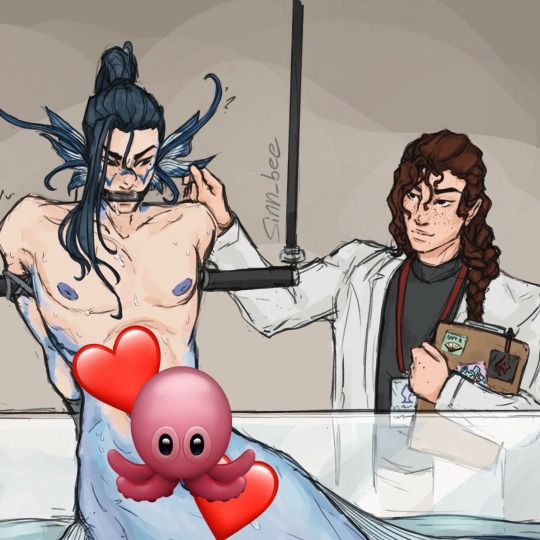
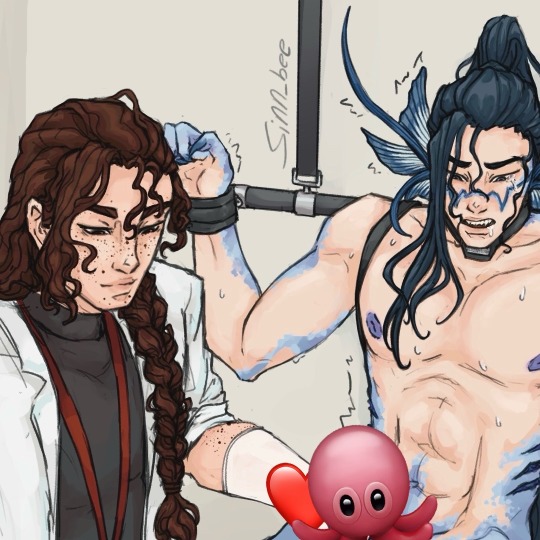
Full uncensored art here ⬇️
Lab assistant Luo Binghe is taking diligent notes on his observations during his studies of mer reproductive anatomy and behaviors >:3c Lead scientist Shen Yuan has no idea this is happening yet but he won’t be too upset since Binghe did such a good job writing down his scientific observations…right?
#continuation of the sketch I posted from magma the other day#I have so much speculative biology in my head and also just so many ways to bully mer Lqg its so great#idk how many of these I’ll make this month but it’s making my brain spin fast#sinn bee art#svsss fanart#svsss#liu qingge#svsss liu qingge#svsss luo binghe#luo binghe#bingliu#mermay#nsft#monsters#mermaid#merliu
103 notes
·
View notes
Text
Concept:
North American Hippogriffs and Griffons.
Having the avian part of a loon, and either an elk or mountain lion, as mammal parts respectively.
They’d have the most fucked up and haunting blood curdling calls.
I love them.
#shit post#shitpost#monsters#making mosnsters#Cryptids#new Cryptids#monster biology#Hippogriffs#griffons
29 notes
·
View notes
Text
The Gargantuan Fossil
This post was from the beginning of my project, thus some information I’ve written here is outdated. Please read my recent posts to see up to date information.
The Gargantuan Fossil is one of the most recognizable parts of the mid-portion of Subnautica’s gameplay. Its sheer size strikes both terror and awe into the hearts of players who stumble upon it. It’s unfortunate that only a third of the creature’s fossilized remains can be seen. Even using the Freecam command to check under the map reveals that the rest of the skeleton remains unmodeled. This is all we have of the Leviathan.

“Gargantuan Fossil” is quite the accurate name, considering just a third of this creature’s skeleton measures 402 meters in length, with the creature’s total size being an estimated 1,100-1,500 meters. Just the skull itself is under 100 meters, and our human player character can nestle comfortably in even its smallest eye socket. I would’ve tried to show our human character’s model for a size comparison, but this thing is so large you wouldn’t even be able to see him.
There have been many different reconstructions of this behemoth of a fossil, the most popular being this commission piece made by Tapwing, for the YouTuber Anthomnia, shown below. And while it’s cool, it’s... not all that accurate.
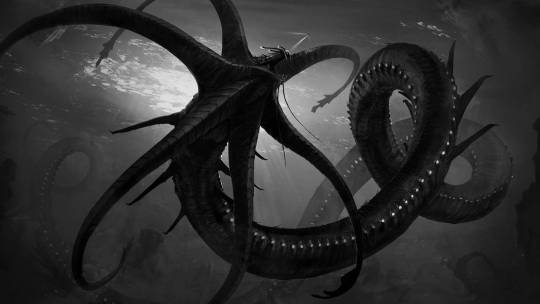
In the past, I actually helped create a Gargantuan Leviathan mod based off Tapwing’s concept, working alongside other incredibly talented artists (who will remain anonymous, they can talk about their experiences as they please) and some... not so savory individuals. I don’t want to be associated with that old Garg. This reconstruction project is both a way for me to move on and make something better than what I had in the past, and to test my skills and knowledge in the various natural sciences.
Although there is a second specimen, the skull of a younger instance, this fossil holds no significant data outside of showing just how small these creatures start out as. As shown in the image below, despite being a much younger instance, our player character could still fit inside the Leviathan’s smallest eye socket, although it wouldn’t be as spacious as its adult counterpart.
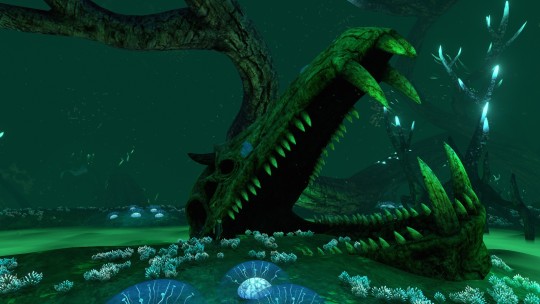
The game’s PDA (Personal Data Assistant) states that the Gargantuan Fossil is approximately 3 million years old, which is INCREDIBLY RECENT. For reference, 3 million years ago we still shared the planet with multiple other hominid species like Australopithecus afarensis back in the mid Pliocene. The Subnautica we know today is a byproduct of a mass-extinction of megafauna, such as Leviathans. My guess as to how the Gargantuan got this big is a combination of deep-sea gigantism and an evolutionary arms race against the other megafauna alive during its time, with prey attempting to become larger than its predator to avoid predation, and the predator growing to continue this cycle. When this ancient ecosystem of leviathan-class super predators collapsed, likely because of the meteor that struck Planet 4546B, the Gargantuan Leviathan was out of a substantial food source and went extinct. It could be possible that these creatures even gave live birth due to their serpentine body and massive size, making them too large for life in the shallows, where laying eggs is easiest.
NOW. LET’S TALK ABOUT THE BONES!! It’s important to figure out if the Gargantuan Leviathan had a cartilaginous skeleton or a bony one, so let’s count the bones!!
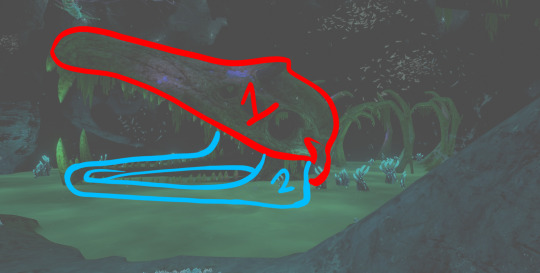
There’s TWO WHOLE BONES!!! AND IF YOU LOOK NEXT TO IT!! THOSE RIBS ARE BONES TOO!!!! UWAA!!! SO MANY BONES!!!! How can we tell this is bones? It’s simple! Cartilage is rubbery and flexible, so it doesn't fossilize well, while bone is hard and rigid, perfect fossil material!! Cartilaginous skulls also tend to be made up of many little interlocking bones, with bony skulls being made up of only a small handful!
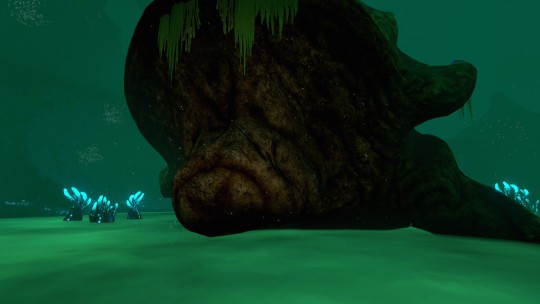
Another thing I found interesting about the Gargantuan Skull is that it seems to have a ball and socket joint? This could have just been a similar mishap to the top and bottom jaws being fused in the skull’s model, but I’m trying to keep things as close to the original anatomy as possible. The ball and socket joint probably evolved to help with the burden of such a massive and heavy skull and allowing for greater speed and range of motion. In a world full of Leviathan-class predators, being able to have a wide range of motion would be extremely beneficial in locating both potential predators and prey.
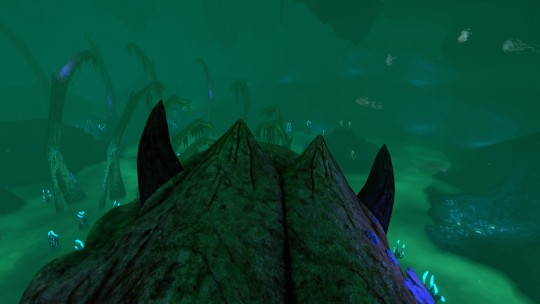
Despite its immense size pushing the claim this Leviathan was an apex predator, it sports a small pair of horns, which is unheard of in large apex predators here on Earth. The darker coloration leads me to believe that these aren’t just horn cores, but the entire horn. These horns were most likely used to assist in defending itself against predators while it’s still small and vulnerable. It could also be a possibility they were used for threat displays and territory fights though it seems unlikely due to their small size. Sexual displays are also unlikely since just about every creature in Subnautica seems capable of asexual reproduction, as noted in the PDA entry for eggs. Asexual reproduction seems to be a very ancient basal trait in Planet 4546B’s evolutionary lineage and was most likely evolved to help species persevere even with low numbers and harsh conditions, preventing the dangers of inbreeding.
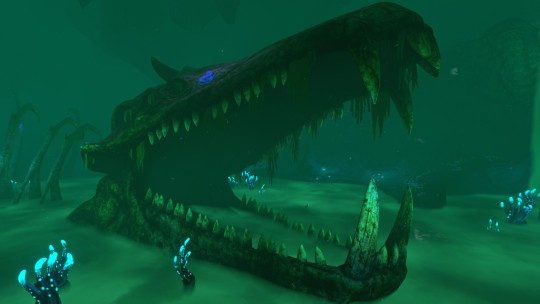
Overall, the skull’s shape and tooth structure suggest a piscivorous diet (of course it eats fish, the planet’s 99% water), and its shape specifically is reminiscent of an Orca and Redondasaurus. The lack of nostrils stumps me, there’s no openings in the skull aside from its eye sockets, however there’s also no evidence for a gill apparatus. I’m... going to have to come back to that at a later date. Though I personally believe the Gargantuan Leviathan was an air breather due to the lack of evidence for gills.
OKOK, ENOUGH ABOUT THE SKULL ASRIEL, WHAT ABOUT THE RIBS?
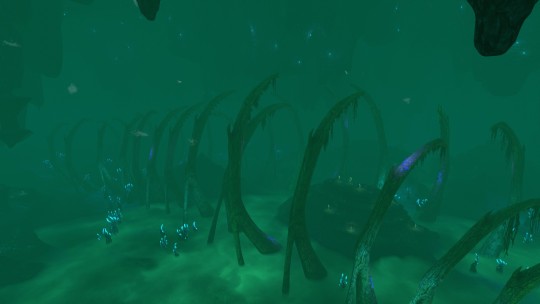
WELL... THE RIBS ARE... SOMETHING.

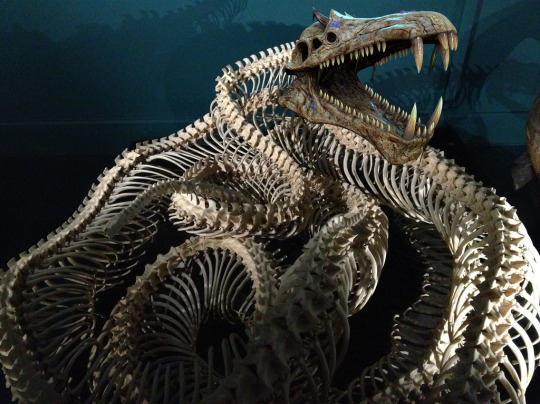
Behold! My very poor photomash of the same two images to show the total approximate length of the Gargantuan Leviathan, and a bad edit to show off what I believe the whole skeletal system would look like! (skeleton image credit)
Despite the game’s PDA describing the Gargantuan Leviathan’s body as “eel-like,” its skeletal structure is more reminiscent of a snake. The ribs show no indication of limbs, so it probably had a dorsal fin similar to eels or sea kraits.
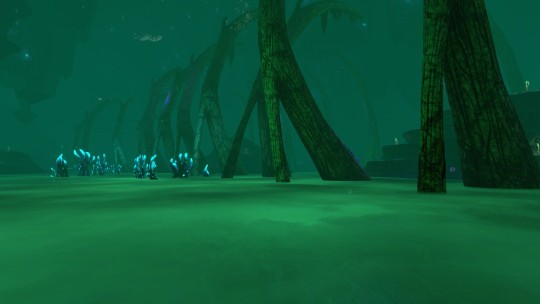
One thing I’ve noticed about the Gargantuan’s ribcage is the existence of what appear to be bony, avian-like uncinate processes, which help the trunk’s muscles pump in and air out of the body, adding onto the idea that this leviathan breathed air. These uncinate processes in diving birds are especially long, which help reinforce the body and musculature, allowing the animal to stay underwater for longer periods of time.
My hypothesis for the role the Gargantuan Leviathan played in its ecosystem is similar to the Sperm Whales of our world, taking in large amounts of air before diving into the depths to fetch their food.
Next week, I’ll be doing more research into the skeleton and possibly beginning work on fleshing the Garg out! If there are any sciencey folks out on Tumblr who want to add their own input, feel free!! I want information!! Correct me if I got anything wrong!!
#long post#VERY long post#speculative biology#speculative paleobiology#paleontology#marine biology#fictional biology#subnautica#character analysis#monster biology#leviathan#gargantuan leviathan#essay
464 notes
·
View notes
Text


if i had a nickel for every person that fell into the underground id have eight nickels which isn’t a lot but it’s weird it happened eight times right?
#undertale#my art#chara dreemurr#frisk undertale#frisk the human#digital art#fanart#i made up this fun idea that human souls are#actually like also the human hearts that have leftover magic from ancestors in the war between monsters and humans before humans#assumingly stopped using magic all together#and you physically have too remove the heart from a person if you want their soul#ive been thinking about undertale again A LOT recently#and how you can depict monster and human biology#its just so cool#i might make a post going into it in a bit more detail as well as one for monsters and how they differ#im so normal about these pixelated indie games i swear to you#totally so normal cough#asgore and his literal underground organ harvesting scheme
23 notes
·
View notes
Text
Ruminations on boss monster SOUL power transfer and aging
So, uh. That one bit of Gerson dialogue. What did he mean by this???
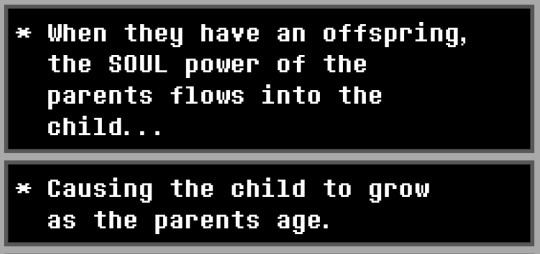
Taken from Hushbugger's Undertale Dialogue Dump page on Github.
There are a few different headcanons/theories about how exactly this piece of lore should be interpreted – and, specifically, what its implications are regarding the children's growth rates in different scenarios. So, let's discuss it.
Personally, I'm REALLY not a big fan of the one that implies a boss monster whose parents die would be stuck as a child forever??? For instance, how would this theory of power transfer work with boss monster families that have 3+ children? Because like. Some couples having at least 3 children would be the only way for the population to to ever grow in size (unless we also headcanon that new boss monsters just spontaneously appear sometimes or something, which has absolutely no basis in canon lore). And by that logic, generations of this happening would eventually yield boss monsters who stop aging stupidly young. Not to mention, what about boss monster kids like Asriel, with no biological siblings? Would them getting both of their parents' SOUL power mean they go through super-puberty that turns them into double-mature adults??? So, yeah, not only would this all have pretty horrific implications regarding boss monster dating, but it'd also just be... really cursed worldbuilding that falls apart when you give it in any amount of serious thought. That's why I think it's a lot more likely that SOUL power transfer is simply that: a transfer of power.
I think Gerson's word choice is key here: "causing the child to grow" – rather than "mature", "age", or " develop" – "as the parents age" – as in, "into old age", becoming physically weaker due to giving up SOUL power.
I believe it's FAR more likely that, if a boss monster was orphaned, their growth would be stunted and their power would never reach its full potential – something more akin to malnutrition, rather than them literally being frozen in time; this would also happen, but to a lesser extent, to a boss monster who has to share their parents' SOUL power with more than one other sibling – and, inversely, a boss monster who's an only child would inherit both of their parents' power, growing far stronger than either of them separately by the time they become an adult.
This would also explain Asgore's absurdly high stats compared to Toriel's – like. ok. he has 8 times her total HP??? If we are to assume Asgore started out with similar stats to Toriel, plugging the numbers into the LV-based HP calculation formula the game uses for Frisk – 3/4 base HP + (1/4 base HP * LV) – gives us this equation: 330 + 110*LV = 3500. Solving for Asgore's hypothetical LV, then, gives us LV of roughly 29. Which might not sound that bad... until you realize the EXP required for getting to LV 19 is more than than all of the EXP it takes to get to LV 18 combined. Even assuming the EXP you get from killing just one human is equivalent to killing every monster in the Underground, while also assuming that the amount of EXP you need to level up no longer increases after you've reached LV 20 for some reason... it still wouldn't be enough to explain Asgore's dummy thicc HP bar after killing only 6 humans, if we are to assume his base HP is at all similar to that of Toriel. (Accounting for the possibility that monster history books lied, or at the very least didn't tell the full truth when stating that "not a single human SOUL was taken" during the war just leaves us with another problem: Toriel's also a veteran, and in fact seems a lot more comfortable with the idea of actively going to war as opposed to Asgore's approach of stalling for as long as possible, so if monsters actually were getting insane amounts of EXP by killing humans during the war, how come her stats are still so low? Killing even just a few humans would beef her up quite a bit; again, it's only once the numbers get higher that you see the sharp increase in EXP required to level up.)
I think Asgore was born into royalty, and Toriel married into it. Again: if a pair of boss monsters had only one child, that child would have the combined power of their 2 parents – now, let's suppose a family decided to do that for many generations.... with each new kid in such a family, the base power of the resulting offspring would grow more and more and more, wouldn't it? Perhaps one such family also has the means and prestige that allows them to easily find suitably strong partners for their kids, further increasing the rate at which the family's power would grow. (Also, the idea of Toriel originally being a commoner is further reinforced by the fact that the surname "Dreemurr" is confirmed to come from Asgore's side and, at least as far as we know, Toriel just... doesn't have her her own surname, as she switches to just going by "Toriel" after the two break up. Given that we only have about 3 examples of surnames within the Entirety Of The Underground, it appears that family names just aren't really a thing used within monster society, unless said family is really notable in some way).
...I may or may not be overthinking boss monster biology.
#can you guys tell i've been thinking a lot about pre-war monster society#utdr#undertale#analysis#theory#toriel#asgore dreemurr#asriel dreemurr#gerson boom#boss monsters#monster biology#worldbuilding#headcanon#long post#jonah.txt#id in alt text
32 notes
·
View notes
Note
Today I learned that the scientific name of the green iguana is "Iguana iguana iguana" and I think that's delightful.
You may find this list amusing then, as I did when I read your ask and remembered a few others that have the same quirk.
63 notes
·
View notes
Text

Sketch linework for the jaw types present within anthropods. These sketches serve to showcase the jaws and general skull shapes seen for each group of anthropods and does not include such things as antennae types present within each group as it can be highly varied. The red lines denote possible esophagus path.
Anthropods are believed to have split off from arthropods during Atterra's early Carboniferous period around 356 million years ago, developing internal skeletons and a closed circulatory system to help them compete against early the early tetrapod's of their time. As the Carboniferous period drew to a close and their athropod cousins began to shrink due to the lower oxygen levels, anthropods moved into the young hollows of Atterra to avoid competition with Atterra's rapidly diversifying tetrapods during its Devonian period and the rainforest collapse caused by climate change at the end of the world's Carboniferous period.
Anthropods can be divided into two groups based on the number of holes present within it's skull, similar to tetrapods. The first group of anthropods are defined by a singular hole in their skill, a fused upper labrum. Many species also have hinged mandibles held in front of the face which are used to secure and process food. The second group of anthropods are generally closer in shape and structure to anthropods while possessing two holes in their skull. Many species in both groups have a mobile bottom labrum which is used to help bring food further into the mouth with the help of two tongues derived from two palps on either side of the mouths of their ancestors.
#art#artwork#creature#creature art#creature design#digital art#drawing#illustration#monster design#monsters#my artwork#my art#my post#lore#fantasy worldbuilding#worldbuilding#speculative zoology#speculative biology#speculative evolution#speculative ecology#monster art#monster#creature drawing#fantasy creature#creatures#digtal art#digtal drawing#digtal illustration#fantasy art#character design
73 notes
·
View notes
Text
Ok, going to add to the "Trans Noelle antlers" discourse.
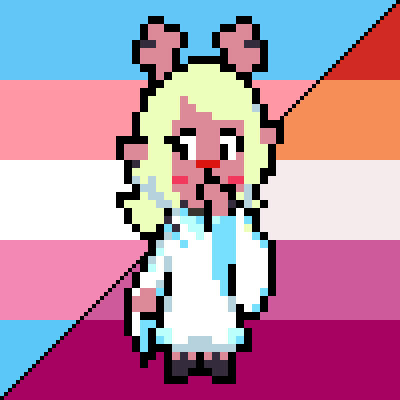
First, disclaimer this is all just for fun and stuff not telling you that Noelle is or is not trans, just had some thoughts after thinking what causes antlers to grow.
Let's go through the debate cycle again.
"Noelle is trans because she has antlers." "Noelle is a reindeer and both male and female reindeer have antlers." "Male and Female reindeer loose their antlers at different times"
I want to add another step to that cycle.
"Would HRT affect when Noelle sheds her antlers?"
From this paper, testosterone lowers when male reindeer are about to lose their antlers, but those that are castrated (and thus dont have any T in their system) actually keep their antlers over the winter in the long run. The study also shows that hormones like estradiol are likely what lets female reindeer keep their antlers into spring.
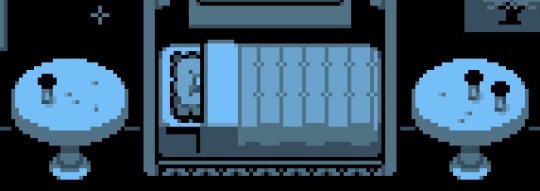
Now this can mean many things for Noelle. If Noelle is on HRT, she would likely have a similar Antler cycle to IRL female reindeers if she like cycled her hormones or something.
(Basically similar to how some folks try and change their hormone doses to match a menstrual cycle, except for Noelle this would be a yearly cycle and not monthly.)
Or, maybe Noelle doesn't cycle her HRT, and in that case idk what would happen. Maybe she'd lose her antlers later then male reindeer, but earlier then female ones. Maybe if its high enough it would keep her antlers for longer, or prevent them from shedding or something? Idk I just skimmed the article and I feel like I'm already doing to much to research a lesbian deer girl from a video game.
Even if Noelle was on puberty blockers, then she'd at least keep her antlers for the winter, like male reindeer without testosterone.
(Also, if Noelle was a deer and not a reindeer, then hormones/blockers would likely prevent her antlers to grow in the first-place once they've been shed.)
I have only just learned (in April) that this is inaccurate for deer. If Noelle was a deer and started blockers before growing antlers, the above is correct. If she started blockers after developing antlers, she'd still grow antlers, it's just they wouldn't leave the velvet stage and wouldn't naturally shed.
I have no clue what HRT would do though because I don't think scientists have injected male deer with estrogen. (COME ON SCIENTISTS DO IT FOR SCIENCE!)
Now I guess there's one more question, if Noelle is trans, would she be able to access HRT or puberty blockers?
Well, Rudy at least supports her identity, so he likely wouldn't have any problem with Noelle medically transitioning.

If Mayor Holiday was transphobic, and had the authority to keep Noelle from gender affirming care like Hormones or blockers, you would think she'd also put her hoof down on her daughter presenting femme too. (and Rudy might have something to say if his transphobic wife tried to prevent his daughter from transitioning.)
Money likely wouldn't be an issue seeing as Noelle's mom's the mayor, (and has been for awhile) and even then the large ornate gate at their house makes me think that Holiday's are on the richer side.
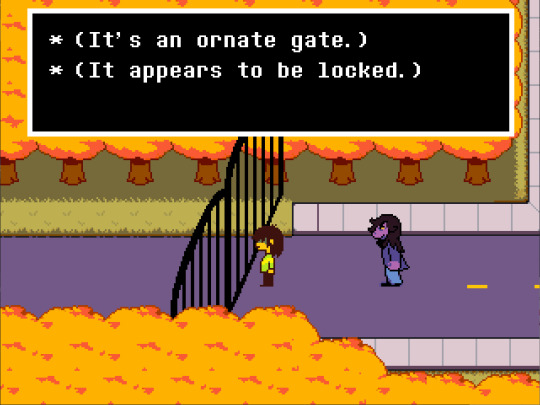
Only way I could see Noelle being trans and not on Hormones or Blockers is either if she for some reason didn't want them, or if Hometown is located in some transphobic country or municipality that banned trans-kids from accessing gender affirming care, and the latter honestly seems a little too depressingly real for a Toby Fox game.
(Insert something plagiarized from Shadow of Roserade's video on UT/DR's queer joy.)
youtube
Now, dispute all this arguing and stuff I think there's one factor we're ignoring here; we're assuming that reindeer monster biology and IRL reindeer biology are analogous.
We don't know how monster reindeer antlers work. Maybe all reindeer monsters have them, but they don't shed them so we cant use antlers to determine if Noelle is trans. Maybe AMAB reindeer monsters grow antlers, their permanent, and Noelle got hers before medically transitioning meaning she'd need like "antler reduction surgery" or something to remove them when she's older.
All the above theorizing means is that if Noelle has a similar antler cycle to IRL female reindeer, it doesn't mean she's cis because HRT can affect that.
There's no way to confirm if Noelle is or is not trans unless like more concrete evidence shows up in later chapters, like estradiol tablets in Noelle's room or something.
The most we've got is unused sprites for Noelle's room in queen's mansion that show pill bottles (Shown earlier in this post). This is still not enough as we don't know what these pill bottles are. They could be anything from anti-depressants to medicine for Rudy! (also the fact the sprites we're never used.)
TL;DR, there's no way to tell if Noelle's trans or cis, and trying to track when her antlers shed is futile as HRT would likely effect that.
I'm still going to pretend she's trans though as I love the headcanon for no particular reason. (spoiler alert, the reason is I'm trans!)
#posts from tigerbear's tumblr#deltarune#deltarune theory#deltarune headcanon#headcanons#noelle#noelle holiday#noelle antlers#trans noelle holiday#transfem noelle#trans#transgender#reindeer#animal biology#i guess#reindeer biology#HRT#rudy holiday#mayor holiday#headcanon#deltarune headcanons#btw when I refer to “male” and “female” reindeer in this post i'm specifically talking about the irl animal reindeer#and how they may be similar to dr monster reindeer#wouldnt use those terms for the dr reindeer monsters bc they have things like gender identities#while irl reindeer do not#also if you notice the post is very slightly different between reblogs that's because I have fixed some grammatical mistakes#and made things slightly more clear
40 notes
·
View notes
Note
naga chair

jokes aside if you just like. sit somewhere with your legs crossed at the ankles its probably like that
i got too far into monsterfucking and now i'm in monster world building 💀 something i haven't been able to figure out is naga lifestyle. what does a naga chair look like? do they even need to sit?? what about a naga bathroom??? how do they get around, can they drive a car???? if not, would they need walkable cities????? or would they call them slitherable cities?????? if there are any handsome nagas out there willing to enlighten me (and also fuck me silly - haha who said that) then i'd love to have a word with them 🙏
yeah i don't know enough about snakes to answer this. 𓆙𓆙𓆙𓆙𓆙𓆙𓆙𓆙
73 notes
·
View notes
Text


A character that’s been cooking in my brain for a while, this is Ackie!
She’s a professional Lovecraftian Horror who likes to wear a reinforced radiation suit while buying her groceries. Her hobbies include surfing the internet and running from the government.
Most of her friends she met via internet forums, most IRL people don’t take too kindly to her for some crazy, unfathomable reason.
#i’m just posting whatever now huh#Please marvel this slimy beast… she has the ideal female form#my art#speculative biology#speculative zoology#alien#alien art#xenobiology#creature design#body horror#sci fi#alien oc#alien species#monster#monster art#creature art#oc art
144 notes
·
View notes
Text
Thinking about spiracles (the multiple holes in a bug's body they breathe through)

I've been wanting to add spiracles to my bug boy oc for a bit now. I always thought spiracles were a really cool aspect of bugs. But..
Then I'm thinking about another 'lines of holes' that mammals have. The milk line

So for oc design.. If I wanted to add spiracles to my bugboy should... he UHHHH
Do you think humanoids with spiracles would breathe through their nipples?
#bugs#insects#speculative biology#character design#my posts that I made#humans have a potential for holes already and that is the milk line. however ..#i could put the spiracles over the side of the body. but in sketching it I can only really fit three -#as a spiracle under the armpit and over the hip joint wouldn't work that well..#maybe i can give him multiple little ones running down his side#anyway posting this on tumblr because i feel like someone here might have better ideas about this than me#the oc in question is half human and half insect monster. he is not really his own species
12 notes
·
View notes